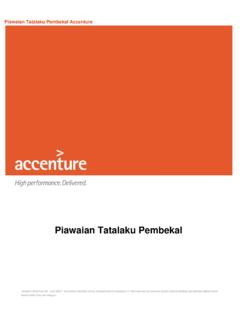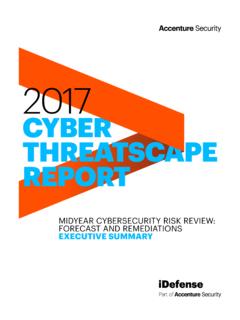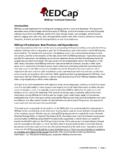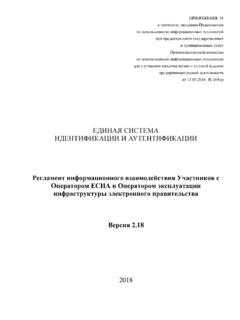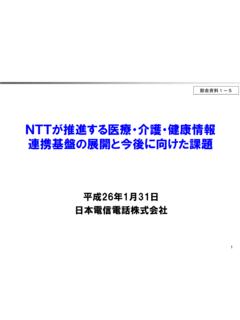Transcription of PSD2 & Open Banking Security and Fraud Impacts …
1 accenture Payment Services & accenture Technology AdvisoryPSD2 & open Banking Security and Fraud Impacts on Banks Are You Ready?Table of ContentsLegal NoticeAccenture is a global provider of professional information technology solutions and services. Views and opinions expressed in this document are based on accenture s knowledge and understanding of its area of business, markets and technology. The Information provided in this document does not purport to reproduce the exact requirements of the Payment Services Directive (PSD2), draft Regulatory Technical Standards (RTS), General Data Protection Regulation (GDPR) or any other legal or regulatory material and may not be read to constitute legal advice or legal interpretation of such requirements. The reader must rely on their legal and financial representatives to interpret the below information as well as the said requirements, rules of access to the regulated payment systems and underlying operational functions, as well as the precise manner of such access.
2 At the time of this document, the enforcement of the draft PSD2 is pending subject to the formal adoption by the EU Council of Ministers. Once passed, the Directive will be published in the Official Journal of the EU. From that date, Member States will have two years to introduce the necessary changes in their national laws in order to comply with the new rules. The RTS on strong customer authentication and secure communication is key to achieving the objective of the PSD2 of enhancing consumer protection, promoting innovation and improving the Security of payment services across the European Union. The General Data Protection Regulation is expected to become law in May 2018. 23 IntroductionThe European Union s revised Payment Services Directive (PSD2) will open the way to a new era for payments in Europe. PSD2 s core objectives include enhancing consumer protection against Fraud and liability accountability across the payment ecosystem.
3 Strong customer authentication along with secure communication is key to achieving this goal. By allowing customers accounts to be accessed via application programming interfaces (APIs), PSD2 enables entirely new types of payment service namely third-party payment initiation provided by Payment Initiation Service Providers (PISPs), and third-party account access provided by Account Information Service Providers (AISPs).In August 2016, the European Banking Authority (EBA) published a consultation paper with a first draft of the Regulatory Technical Standards (RTS), a set of minimum requirements with which all Payment Services Providers (PSPs) including banks, acting as Account Servicing Payment Service Providers (ASPSPs) will have to comply. Some notable aspects of the EBA s draft RTS are summarised below. The Security of electronic payments is fundamental in order to ensure the protection of users and the development of a sound environment for e-commerce.
4 All payment services offered electronically should be carried out in a secure manner, adopting technologies able to guarantee the safe authentication of the user and to reduce, to the maximum extent possible, the risk of Fraud . Payment Services Directive (PSD2), recital 95 Authentication procedures will use the three elements knowledge, possession, inherence. Dynamic linking and channel independency: the channel, mobile application or device where the transaction information is displayed must be independent of the one used to initiate the payment Mutual Authentication Mechanism between TTP (PISP, AISP) and ASPSP (bank): the EBA proposes the use of Website Certificates issued by qualified Trust Service Providers (TSPs) based on the eIDAS framework. The EBA says there will be a qualified TSP designated under eIDAS not before October 2018.
5 The RTS sets out exemptions from performing SCA and asking the user to enter Authentication Codes for every transaction. These exemptions for PISPs, AISPs and PSPs will enhance convenience for users. Security standards will be in compliance with ISO 27001. Banks must open up their payments and core Banking systems to TPPs using ISO20022 or other industry standard. Bank-specific technical specification documents, routines, tools and examples must be made available on the bank s website to be downloaded by anyone free of charge. The APIs with the bank s underlying services (payment instruments, account information) must be granted to the TTPs under the same SLAs as granted to the bank s own services, such as online the EBA s draft RTS: 4 Defining strong customer authentication As the RTS specifies, PSD2 s strong customer authentication is based on two or more of three elements that are independent of one another.
6 Alongside this authentication, PSD2 requires PSPs to have in place Security measures to protect the confidentiality and the integrity of the payment service user s (PSU s) personalised Security credentials when the payer:a) accesses its payment account onlineb) initiates an electronic payment transaction c) carries out any action, through a remote channel, which may imply a risk of payment Fraud or other abuses. abuses. With the initiation of electronic remote payment transactions, PSD2 again requires payment service providers to apply strong customer authentication, which must include elements that dynamically link the transaction to a specific amount and a specific Customer Authentication means an authentication based on the use of two or more elementsKnowledgeSomething only the user knowsPossessionSomething only the user possessesInherenceSomething the user isExemptions from strong customer authentication PSD2 allows for exemptions from having to apply strong customer authentication, based on the following criteria.
7 A) the level of risk involved in the service provided b) the amount and/or the recurrence of the transactionc) the payment channel used for the execution of the also introduces a liability shift, as the providers who fail to authenticate a transaction appropriately will now be held liable for any resulting breaches. In cases where the payer's PSP does not require strong customer authentication, the payer will not be required to bear any financial losses unless the payer has acted fraudulently. In cases where the payee or the payee s PSP fails to accept strong customer authentication, it will be required to refund the financial loss caused to the payer s Question Given the need for at least two out of three different elements to be used for customer authentication, have you decided what elements you will use, and how?
8 5 Digital IdentityCustomer Authentication Even after the release of the EBA s draft RTS, it remains unclear what the authentication technologies will ultimately look like. However, accenture expects to see the adoption of a standardised, simple and user-driven authentication framework such as OAuth and its extension OpenID Connect, which allows authentication and authorisation without disclosing the user s credentials to terms of practical implementation, it appears likely that most banks will decide to rely on the knowledge factor option such as a PIN, and then choose between possession and inherence as the second draft RTS created some uncertainty regarding the second element, possession. The independence of channels plays a vital role in a multi-channel environment, especially in a mobile ecosystem of desktops, mobile devices and mobile applications.
9 It is important that the authentication code is not transmitted through the same channel that the customer has used to initiate the authentication will focus on possession-based solutions using one device both for the initiation of the authentication procedure and the reception of the authentication code. Therefore, the technical separation of the different authentication elements within one device will play an important role, and should be considered by banks while reorganising their authentication a possession-focused solution would be irrespective of the challenges technologically strong, it may not provide the level of accuracy required. As a result, many banks are looking into inherence to address the second factor of authentication. Key Question Based on the available information in the draft RTS, OAuth connect is likely to be the preferred authentication protocol.
10 The requirements on possession-based authentication methods have become stronger. Given this, is your organisation ready for OAuth-based customer/TPP authentication and technically separated possession-based authentication methods?67 Cyber Security By providing their APIs to TPPs, banks open up a significantly greater attack surface to potential cyber adversaries, and can no longer hide critical applications behind perimeter firewalls. However, banks that follow a sound architectural approach can mitigate these issues, by integrating Security requirements with the fundamental business drivers and business cases. This helps to ensure that their Security processes are adaptive and responsive to threats while also being tightly coupled to business Impacts . Here is a high-level reference architecture for a bank s APIs: Threat protectionDevelopersAppsDDoSCore Banking systems (CBS, CIS, Fraud , payments)TLSRate limiting & quotaPlayload protectionAnalyticsCertificatemanagement Keys / tokenmanagementPolicymanagementRBAC managementUsermanagementSecurity policies & proceduresCompliance (SOC 2) and cloud securityActors / ConsumerIdentity & access managementAuthorizationAuthentificationP olicy enforcementTra c managementLogging &auditingAPI securityPolicy storeLog storeKey storeInfoSec / APIarchitect / DevOpsSOAP8 Authentication and AuthorizationContent Based AttacksData EncryptionIdentity TrackingMessage ValidationTra c ManagementUse API Keys for app authentication at a minimum and restrict access for apps to their allowed resources.






